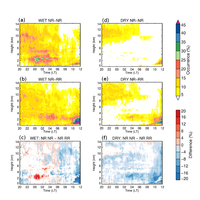What drives daily precipitation over the central Amazon?
Submitter
Biscaro, Thiago — National Institute for Space Research
Area of Research
Cloud Processes
Journal Reference
Biscaro T, L Machado, S Giangrande, and M Jensen. 2021. "What drives daily precipitation over the central Amazon? Differences observed between wet and dry seasons." Atmospheric Chemistry and Physics, 21(9), 10.5194/acp-21-6735-2021.
Science

Figure 1. Cloud occurrence and absolute differences between non-raining and raining transitions for wet and dry seasons. (a) Wet-season NR–NR cloud fraction; (b) wet-season NR–RR cloud fraction; (c) wet-season cloud fraction difference between NR–NR and NR–RR modes; (d) dry-season NR–NR cloud fraction; (e) dry-season NR–RR cloud fraction; (f) dry-season cloud fraction difference between NR–NR and NR–RR modes. Non-significant differences (areas where differences and their standard deviations overlap) are marked in white in panels (c) and (f). From journal.

Figure 2. Mean GOES 10.4 µm brightness temperature fields and absolute differences from 20:00 to 08:00 LT for dry and wet seasons and NR–NR and NR–RR transitions. The cross marks the T3 position. Non-significant differences (areas where differences and their standard deviations overlap) are marked in white. From journal.
We offer an alternative presentation regarding how diurnal precipitation is modulated by convective events that developed over the central Amazon during the preceding nighttime period.
Impact
We suggest that there are two distinct modes driving diurnal precipitating convective clouds over the central Amazon. In the wet season, local factors such as turbulence and nighttime cloud coverage are the main controls of daily precipitation, while dry-season daily precipitation is modulated primarily by the mesoscale convective pattern. Therefore, models and parameterizations must consider different formulations based on the seasonal cycle to correctly resolve convection.
Summary
Local surface-based observations of cloud occurrence, soil temperature, surface fluxes, and planetary boundary-layer characteristics are coupled with satellite data to identify the physical mechanisms that control the diurnal rainfall in central Amazonia during the wet and dry seasons. This is accomplished through evaluation of the atmospheric properties during the nocturnal periods preceding raining and non-raining events. We use data collected during the Observations and Modelling of the Green Ocean Amazon (GoAmazon 2014/15) field campaign that took place from 1 January 2014 to 30 November 2015 in the central Amazon.
Keep up with the Atmospheric Observer
Updates on ARM news, events, and opportunities delivered to your inbox
ARM User Profile
ARM welcomes users from all institutions and nations. A free ARM user account is needed to access ARM data.


















